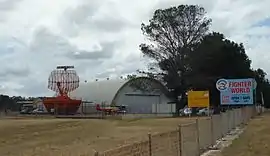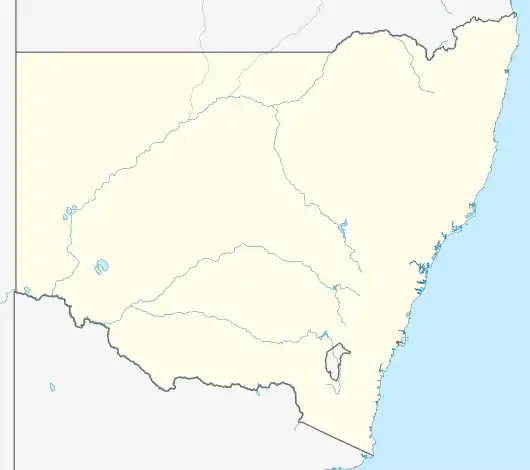| Williamtown New South Wales | |||||||||||||||
|---|---|---|---|---|---|---|---|---|---|---|---|---|---|---|---|
 Fighter World Museum at RAAF Base Williamtown | |||||||||||||||
 Williamtown | |||||||||||||||
| Coordinates | 32°48′54″S 151°50′34″E / 32.81500°S 151.84278°E | ||||||||||||||
| Population | 762 (2021 census)[1] | ||||||||||||||
| • Density | 16.97/km2 (44.0/sq mi) | ||||||||||||||
| Postcode(s) | 2318 (Williamtown), 2314 (Williamtown RAAF) | ||||||||||||||
| Elevation | 5 m (16 ft)[Note 1] | ||||||||||||||
| Area | 44.9 km2 (17.3 sq mi)[Note 2] | ||||||||||||||
| Time zone | AEST (UTC+10) | ||||||||||||||
| • Summer (DST) | AEDT (UTC+11) | ||||||||||||||
| Location |
| ||||||||||||||
| LGA(s) | Port Stephens Council[2] | ||||||||||||||
| Region | Hunter[2] | ||||||||||||||
| County | Gloucester[3] | ||||||||||||||
| Parish | Stowell[3] | ||||||||||||||
| State electorate(s) | Port Stephens[4] | ||||||||||||||
| Federal division(s) | Paterson | ||||||||||||||
| |||||||||||||||
| |||||||||||||||
Williamtown is a rural suburb of the Port Stephens local government area in the Hunter Region of New South Wales, Australia.[2][6] It is located on the main road between Newcastle and Nelson Bay.[7]
Geography
The eastern section of Williamtown is dominated by RAAF Base Williamtown and Newcastle Airport while the western section of the area is primarily semi-rural with some large-acreage residential areas scattered along Cabbage Tree Road which is a main access route to Port Stephens from the Pacific Highway. To the south Williamtown reaches Fullerton Cove, a large cove at the Hunter River. The south-eastern corner of the area reaches the Tasman Sea on Stockton Beach and access to the beach is possible at this point for off-road vehicles via Lavis Lane..
Population
In the 2016 Census, there were 885 people in Williamtown. 70.9% of people were born in Australia and 80.7% of people spoke only English at home. The most common responses for religion was Anglican at 22.8%.[1]
Tomago sandbeds
Most of Williamtown sits atop the Tomago sandbeds (an aquifer that is a critical source of water for the lower Hunter Region). The sandbeds are replenished primarily by rain as well as any water that leaks from Grahamstown Dam in nearby Ferodale. Water from the sandbeds and the dam is treated in Tomago.[8]
Notes
References
- 1 2 Australian Bureau of Statistics (27 June 2017). "Williamtown (State Suburb)". 2016 Census QuickStats. Retrieved 3 July 2018.
- 1 2 3 "Suburb Search - Local Council Boundaries - Hunter (HT) - Port Stephens". New South Wales Division of Local Government. Retrieved 16 June 2008.
- 1 2 "Williamtown". Geographical Names Register (GNR) of NSW. Geographical Names Board of New South Wales. Retrieved 16 June 2008.
- ↑ "Port Stephens". New South Wales Electoral Commission. Retrieved 23 November 2019.
- 1 2 3 "Williamtown RAAF". Climate statistics for Australian locations. Bureau of Meteorology. Retrieved 24 June 2020.
- ↑ "Williamtown". Australian Explorer. Retrieved 16 June 2008.
- ↑ "Williamtown". Land and Property Management Authority - Spatial Information eXchange. New South Wales Land and Property Information. Retrieved 16 June 2008.
- ↑ "Tomagos & Anna Bay Sandbeds". Hunter Water. Retrieved 16 June 2008.